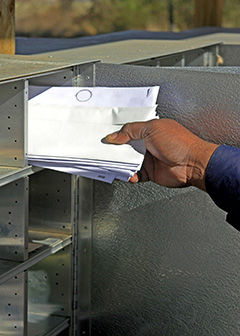Summary
Please enable javascript to play this video.
| Quick Facts: Postal Service Workers | |
|---|---|
|
$57,870 per year
$27.82 per hour |
|
| No formal educational credential | |
| None | |
| Short-term on-the-job training | |
| 500,000 | |
| -5% (Decline) | |
| -22,900 | |
What Postal Service Workers Do
Postal service workers sell postage and related products and collect, sort, and deliver mail.
Work Environment
Postal service clerks and mail sorters, processors, and processing machine operators work indoors, typically in a post office. Mail carriers mostly work outdoors, delivering mail.
How to Become a Postal Service Worker
Although no formal education is typically required to enter these occupations, most postal service workers have at least a high school diploma. All applicants for these jobs must pass a written exam.
Pay
The median annual wage for postal service workers was $57,870 in May 2024.
Job Outlook
Overall employment of postal service workers is projected to decline 5 percent from 2024 to 2034.
Despite declining employment, about 34,500 openings for postal service workers are projected each year, on average, over the decade. All of those openings are expected to result from the need to replace workers who transfer to other occupations or exit the labor force, such as to retire.
State & Area Data
Explore resources for employment and wages by state and area for postal service workers.
Similar Occupations
Compare the job duties, education, job growth, and pay of postal service workers with similar occupations.
More Information, Including Links to O*NET
Learn more about postal service workers by visiting additional resources, including O*NET, a source on key characteristics of workers and occupations.
 United States Department of Labor
United States Department of Labor












